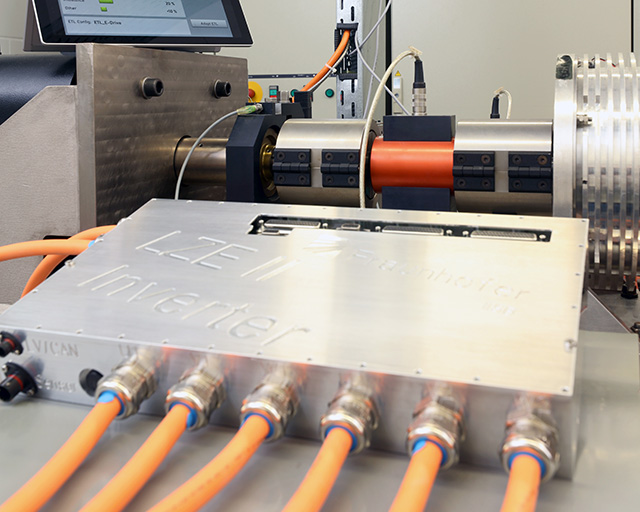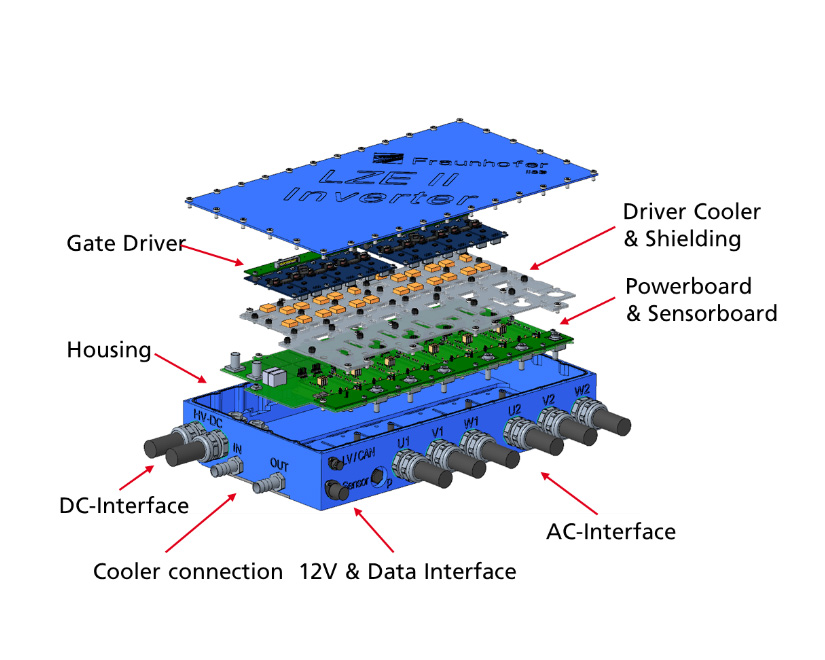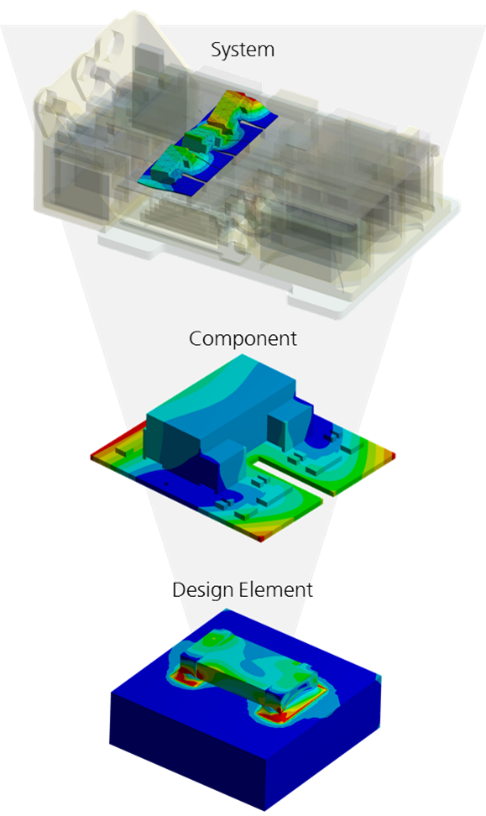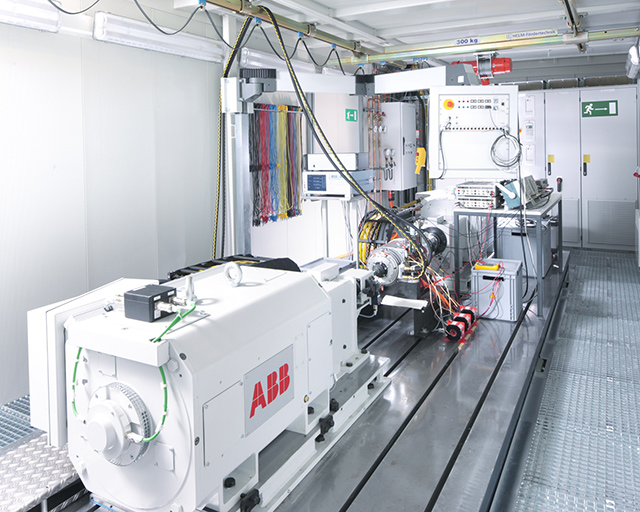The trend towards decarbonization leads to a rapidly progressing electrification in all relevant transport sectors, like automotive, commercial vehicles and aviation. Therefore highly efficient, compact and reliable electric drive systems are required to meet the application-specific requirements. We work on electric drive systems for mobile applications. Our focus is the development of innovative inverter power electronics and electric machine solutions. We can offer a complete in-house research and development, prototype-realization and testing of electric drives.
Drive Inverters & Mechatronics
- Development and prototype realization of inverter power electronics
- Voltage range for automotive applications: 48V up to 900V
- Output power: up to 1 MW
- Focus on Siliconcarbide (SiC) and Galiumnitride (GaN) based inverter systems
- Experience with a wide variety of inverter topologies (Multilevel, Multiphase, etc.)
- Applications: Traction, fuel-cell air-supply, electric turbochargers
- Development and prototype realization of electric machines
- Traction and auxiliary drives for automotive and aviation
- Complete 3D-FEM design of the electric motors (electromagnetical, thermal, mechanical)
- Co-simulation tools to calculate machine behavior in combination with inverter (realistic losses, dynamic, control stability etc.)
- Highly integrated electric drive systems (3D mechatronic integration) for hybrid or electric vehicles
- Field-oriented motor control software development for various machines (e.g. PMSM, IM, SSM, etc.)
- In-house testing possibilities with several motor test-benches and a vehicle dynamometer (incl. 3D integration)
- Vehicle integration of electrical drive and power management systems
- Functional safety concept (ISO 26262, up to ASIL-D)
Click the link to jump to your topic of choice:
SiC-based traction inverter for mobile applications
Wide-Bandgap (WBG) semiconductors, like SiC and GaN transistors, offer the potential for inverter systems with highest efficiencies, power-densities and especially switching frequencies far beyond the state-of-the-art. To achieve the combination of highest output powers/currents for automotive or aviation traction application with highest switching speeds, an adapted design of the commutation cell, the power-module and the gate-drive is required.
Fraunhofer IISB develops customer specific SiC inverter for typical automotive voltage levels (e.g. 400V/800V). Fast switching power-stages (>= 20 kV/µs) with output currents higher than 800 Arms have been realized using simulation models and experimental setups. In-house prototype realization and characterization at the IISB motor test-benches can be offered.
SiC-based inverter for High-Speed Motors (e.g. Compressors, Turbochargers)
High-speed electric motors, like compressors, fuel-cell air-supply or electric turbo-chargers, require highest inverter output-frequencies and therefore higher switching-frequencies to avoid additional losses and torque-ripple within the machine. In order to meet these demands, investigations and product-developments of inverters with wide-band-gap semiconductors are carried out.
- Nominal DC-link voltage: 400V and 800V
- Output power: 10 to 80kW
- 2-level/3-level topology
- Max. switching frequency: 80-100 kHz
- Sensorless motor control
Integrated Drive Systems
Mechatronic integration of inverter power electronics in or close to the electric machine offers the potential to reduce costs, required volume and EMC-issues. But this placement of electronics close to the electric machines also leads to a higher level of thermal and mechanical stress. At Fraunhofer IISB we focus on the development of system architectures and components for electric drives with different integration level. The use of innovative yet production-optimized material concepts and joining technologies enables us to achieve the required robustness.
Our design process includes a complete 3D-FEM and Co-simulation-based toolchain for the electro-magnetic, thermal and mechanical design and optimization of electric machines. A variety of motor test benches and available inverter solutions allow a complete in-house characterization of the prototypes.
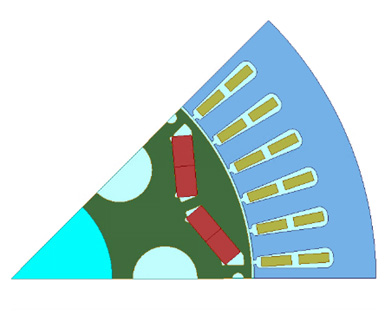
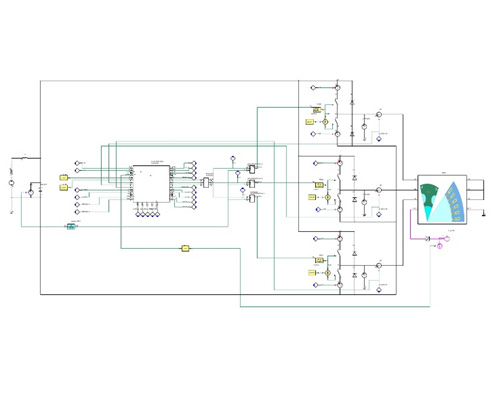
We cover a broad range of motor and drive applications:
- Traction motors and auxilary drives for Automotive and Aviation
- Industrial drives
- Voltage range: 48 V to 1000 V
- Power range: up to > 250 kW
Customized motor designs with focus on:
- Highest power-density
- Highest efficiency
- Advanced cooling solutions
- Integrated solutions with inverter system
Electric machine design based on inverter co-simulation:
- Simulative coupling of SPICE/PLECS inverter simulation with FEM-simulation of electric machine
- Realistic estimation of inverter losses for inverter operation, e.g. harmonics induced rotor losses
- Comparison and optimization of different thermomanagement solutions for rotor and stator (e.g. water-, oil- and air-cooling)
Fraunhofer IISB cooperates with the control engineering laboratory of the Faculty of Electrical Engineering, Precision Engineering, Information Technology (efi) of the ‘Technische Hochschule Nürnberg’ in developing and analysis of modular control algorithms addressing for example the machine types listed below:
- Permanent Magnet Synchronous Motors (PMSM)
- Induction Motors (IM)
- Electrically Excited Synchronous Motor (EESM)
- Brushless DC
- Multiphase and multilevel topologies
The following solutions are covered by our R&D work:
- Conventional drive control methods (e.g. field oriented control)
- Adaptive control of drive systems (e.g. iterative learning control)
- Sensorless control and high frequency control algorithms, e.g. for high-speed drives (electric turbocharger, fuel-cell air supply etc.)
- Implementation and testing on in-house developed control-board hardware (e.g. based on Infineon TriCore or SOC/FGPA)
- Test of the developed drive control systems at the in-house dynamometer facilities
The integration of mechatronic systems into highly stressed spaces demands an indication of product life already in the design phase. External vibrations, e.g. roadway bumps or engine oscillations, excite mechanical structures at their natural frequencies, which may lead to uncontrollable dynamic responses and failures at an early stage. The vibration resistance is further lowered by the operational thermal overlay. Common failure patterns in power electronics are fatigue cracks in solder joints, delamination at material boundaries and fretting corrosion of electrical interfaces. Typically, these robustness failures are electrically detected, but mechanically triggered. In the case of safety-critical devices, failures may have farreaching consequences. These critical load spectra are often found in mounting positions that are unsprung or close to an engine and occur in automobiles, aircrafts or wind turbines.
Possible subjects are approached based on the geometric complexity and may comprise different functional elements:
- Electrical devices: resistors, capacitors, transistors, inductors, transformers
- Electrical interfaces: connectors, busbars
- Circuit boards: multilayer, flex rigid
We offer the following simulation services:
- Thermomechanical robustness simulation of customer systems based on material parameters and CAD files
- Experimental vibration testing on in-house shaker system with 3D laser scanning vibrometer
- Analyzing the physical response of sinusoidal and random vibration signals
- Identification of natural frequencies and measuring frequency responses at any location
- Parameter studies in terms of design, loads and materials
- Optimizing structural design by minimizing thermomechanical response
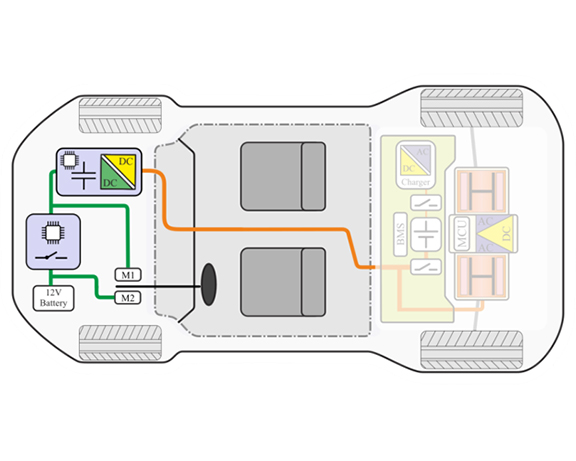
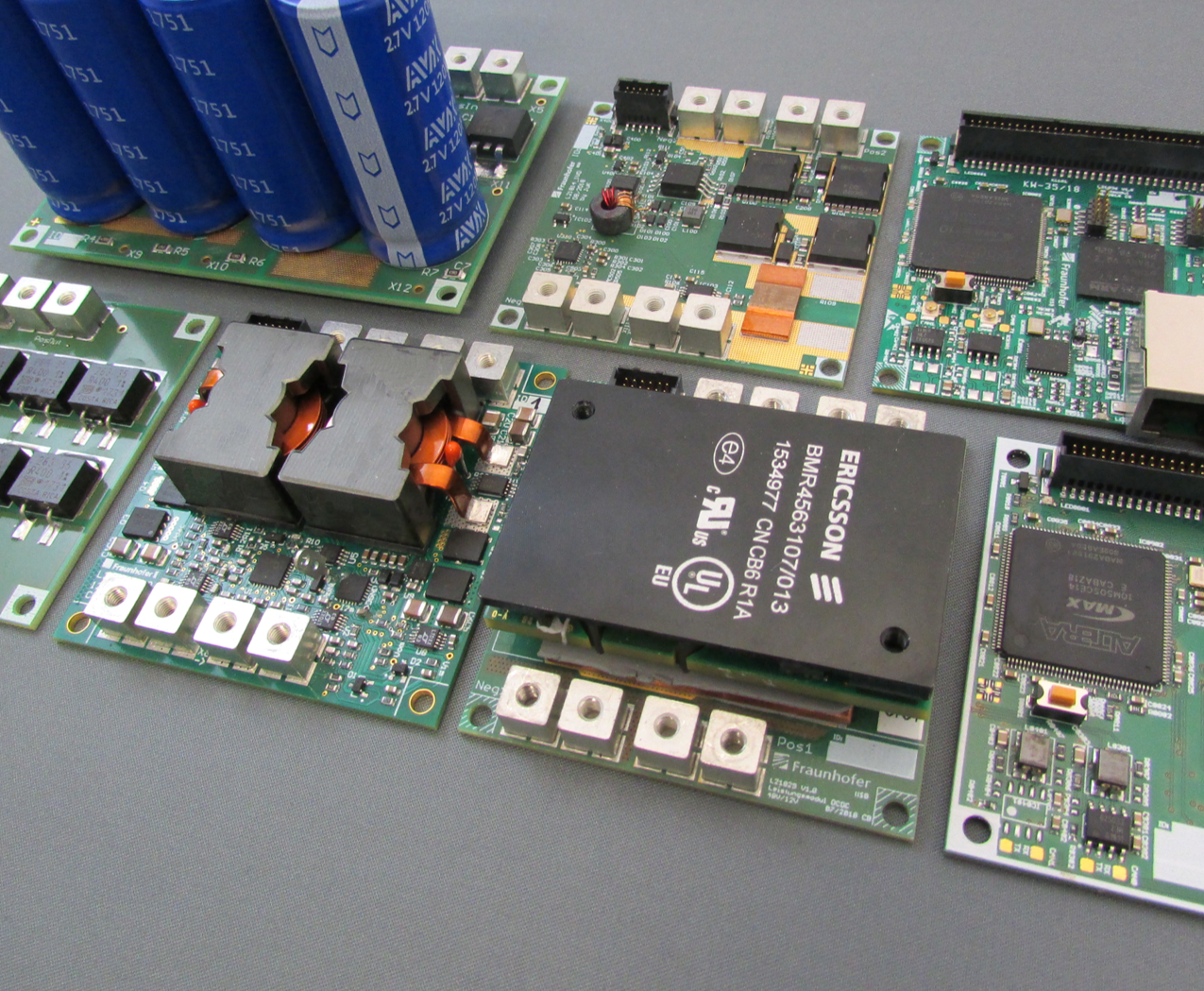
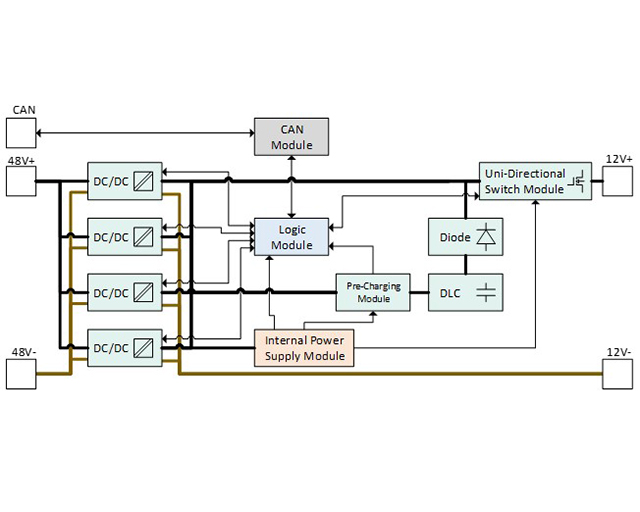
Highly automated vehicles as of SAE level 3 lack the driver as a fallback during power failures.
In the research project HiBord, funded by the German Federal Ministry of Education and Research, new on-board power supply system topologies were investigated which can handle faults in the power supply system without full redundancy.
- Energy flow control
- Fault isolation
- Network reconfiguration
- Local reflexes and global decisions
Advantages:
- Logic module with μC and FPGA for advanced monitoring algorithms and quick fault reactions
- Scalability by using standardized interfaces
- Modules equipped with sensors for current, voltage, temperature
- Different communication options (CAN, Automotive Ethernet, …)
- Scalable housing and cooling solution due to standardized module dimensions and connectors
Modules:
Many modules are available
- Uni-directional and bi-directional switch modules (12V or 48V)
- 48V/12V DC/DC converter module
- Double layer capacitor module
- Active and passive DLC pre-charging modules
- Logic module with powerful FPGA and µC
… and more, depending on project requirements
Application Example
A combination of an on-board DC/DC converter and a DLC was realized with the building set and is a key component of the HiBord power supply system.
.The system combines a DC/DC converter with a transient power storage and thus can replace a 12V battery in fail-operational scenarios.
A variety of motor test benches up to 300 kW and 1000 VDC-power supply are available at Fraunhofer IISB and can be used for the characterization of electric motors and complete drive systems.
- Engine test bench
- Air-conditionable all-wheel roller dynamometer
- Battery tests
- System reliability
- Electromagnetic compatibility (EMC)
 Fraunhofer Institute for Integrated Systems and Device Technology IISB
Fraunhofer Institute for Integrated Systems and Device Technology IISB
